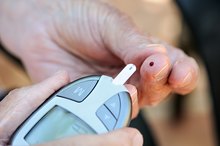What Is a Normal Iron Level in a Toddler?
Iron is a nutrient found in your body that comes entirely from your diet. It is found in fortified cereal, meat, beans and leafy green vegetables. Iron is necessary to make red blood cells and carry oxygen. Most of the iron in the body is found in red blood cells. Iron is also stored in the liver and bone marrow, found in muscle, bound to enzymes, or circulating in your blood bound to protein.
Normal Value of Iron in Toddlers
According to the fourth edition of "Tietz Textbook of Clinical Chemistry and Molecular Diagnostics," normal levels for iron can vary as much as 35 percent among the laboratory methods used to measure iron. Therefore, it is not advisable to provide a generic normal value for iron. Likewise, you should only refer to the normal level from the laboratory performing the iron test of your toddler when interpreting the results. A few different tests measure iron and how it binds to proteins. The assay for serum iron or total iron measures the amount of iron that is bound to a protein in your blood called transferrin. As reported by Quest Diagnostics Laboratory, the normal values for total iron based on its laboratory for a 1- to 3-year-old toddler range from 29 to 91 micrograms per deciliter of blood -- usually written µg/dL -- for a male and 25 to 101 µg/dL for a female.
- According to the fourth edition of "Tietz Textbook of Clinical Chemistry and Molecular Diagnostics," normal levels for iron can vary as much as 35 percent among the laboratory methods used to measure iron.
- Likewise, you should only refer to the normal level from the laboratory performing the iron test of your toddler when interpreting the results.
Significance of Normal Iron Levels in Toddlers
How Long Does Iron Stay in Your System?
Learn More
Iron deficiency in children is a concern in both developing and industrial nations and is a common cause of childhood anemia. It is thought that long-term damage to the brain and nervous system that might be irreversible may be attributed to iron deficiency. Iron deficiency may also lead to learning and behavior problems. Based on this concern, the American Academy of Pediatrics updated its guidelines in 2010 to recommend that at 1 year of age, all children should be checked for anemia.
- Iron deficiency in children is a concern in both developing and industrial nations and is a common cause of childhood anemia.
Related Articles
References
- Camaschella C. Iron deficiency: new insights into diagnosis and treatment. Hematology Am Soc Hematol Educ Program. 2015;2015:8-13. doi:10.1182/asheducation-2015.1.8
- Pawlak R, Berger J, Hines I. Iron Status of Vegetarian Adults: A Review of Literature. Am J Lifestyle Med. 2016;12(6):486–498. doi:10.1177/1559827616682933
- DRI: Dietary Reference Intakes for Vitamin A, Vitamin K, Arsenic, Boron, Chromium, Copper, Iodine, Iron, Manganese, Molybdenum, Nickel, Silicon, Vanadium, and Zinc. Washington, D.C.: National Academy Press; 2001.
- Alaunyte I, Stojceska V, Plunkett A. Iron and the female athlete: a review of dietary treatment methods for improving iron status and exercise performance. J Int Soc Sports Nutr. 2015;12:38. doi:10.1186/s12970-015-0099-2
- Mirza FG, Abdul-kadir R, Breymann C, Fraser IS, Taher A. Impact and management of iron deficiency and iron deficiency anemia in women's health. Expert Rev Hematol. 2018;11(9):727-736. doi:10.1080/17474086.2018.1502081
- Hegazy AA, Zaher MM, Abd El-Hafez MA, Morsy AA, Saleh RA. Relation between anemia and blood levels of lead, copper, zinc and iron among children. BMC Res Notes. 2010;3:133. Published 2010 May 12. doi:10.1186/1756-0500-3-133
- Qin Y, Melse-Boonstra A, Pan X, et al. Anemia in relation to body mass index and waist circumference among Chinese women. Nutr J. 2013;12:10. doi:10.1186/1475-2891-12-10
- Cleveland Clinic. Leukemia. Updated October 31, 2016.
- Merck Manual Professional Version. Iron Deficiency Anemia. Updated July 2018.
- Johns Hopkins Hospital. Iron-Deficiency Anemia.
- Abu-Ouf NM, Jan MM. The impact of maternal iron deficiency and iron deficiency anemia on child's health. Saudi Med J. 2015;36(2):146–149. doi:10.15537/smj.2015.2.10289
- National Institute of Diabetes and Digestive and Kidney Diseases. Hemochromatosis. Updated March 2014.
Writer Bio
Leann Mikesh holds a Ph.D. in pathology. She has trained at the University of Virginia Medical Laboratories and has over 15 years experience in clinical, cancer and immunology research. Dr. Mikesh performed kidney and bone marrow transplantation compatibility testing to put herself through graduate school.









